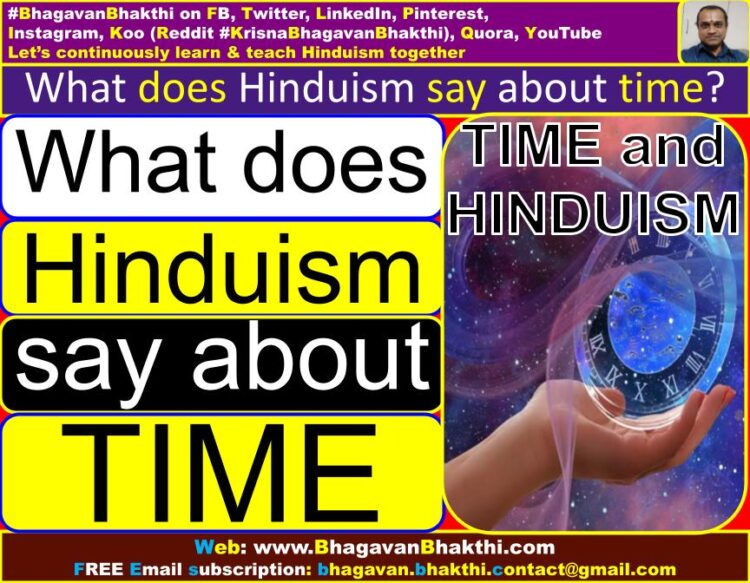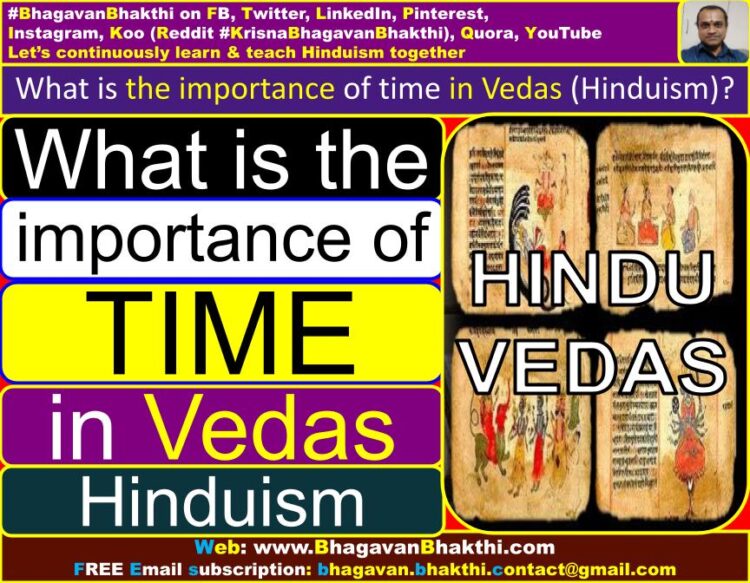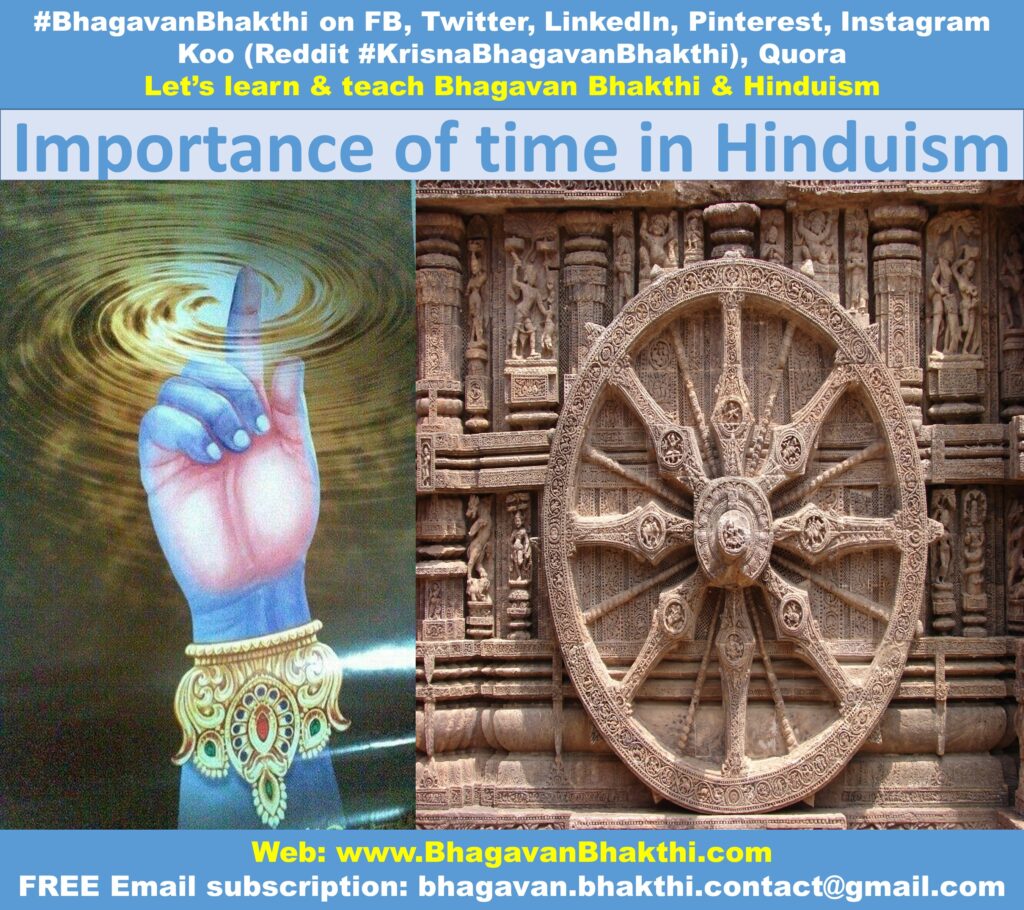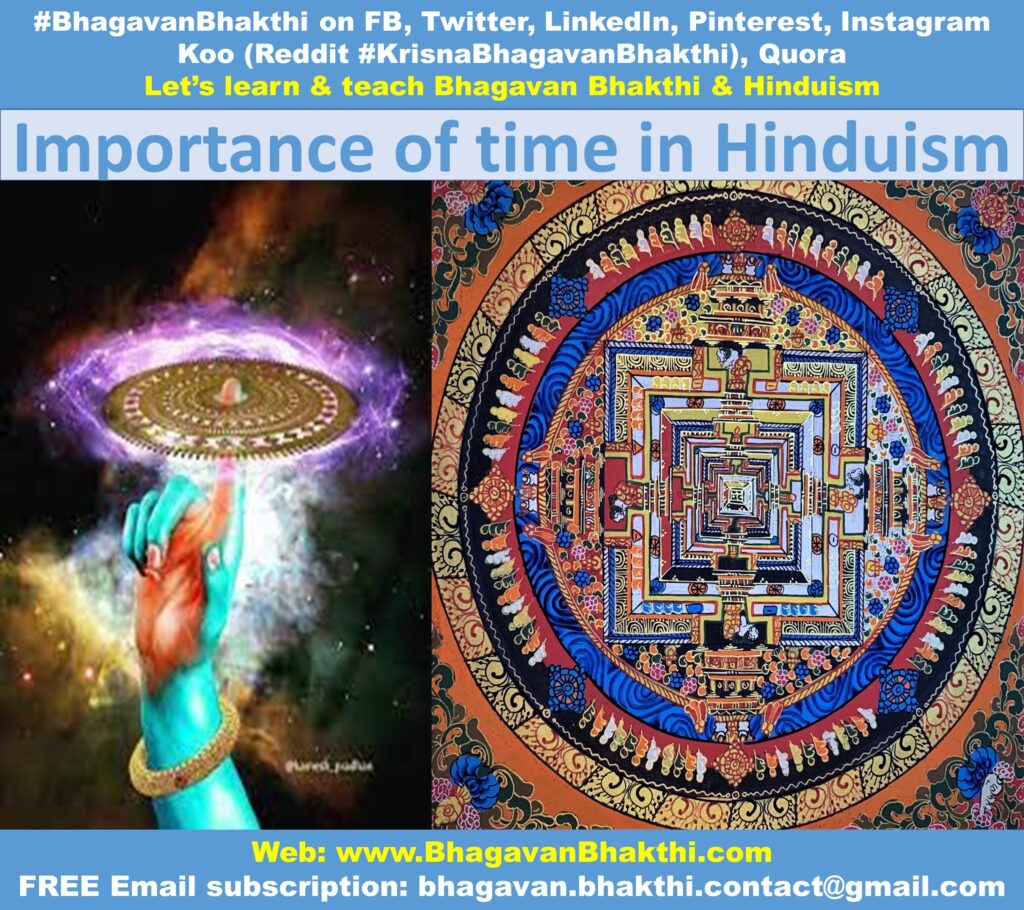What does Hinduism say about time? | What is the importance of time in Vedas (Hinduism)? | What is time according to Vedas? | Who is God of time in Hinduism?
Namaste friends, how are you doing today? Welcome to #BhagavanBhakthi website / blog.
Bhagavan Lord Sri Vishnu (Krishna) (Rama) blessings to you and your family!
In this website / blog, you will always learn about #Hinduism #Sanskrit language.
Also subscribe to my YouTube channel from this link #BhagavanBhakthi to view videos about #Hinduism #Sanskrit language.
Just before going to “What does Hinduism say about time? | What is the importance of time in Vedas (Hinduism)? | What is time according to Vedas? | Who is God of time in Hinduism?“, let us have some brief information.

The Sanatana Dharma (Hinduism) understanding of time is as grand as time itself. Sanatana Dharma and time started at the same time. Most cultures base their cosmologies on familiar units of a few hundreds or thousands of years, the Hindu concept of time spans billions and trillions of years.
The Puranas (Hindu texts on the history of Hinduism) describe units of time from an infinite triti of duration 1/1,000,0000 of a second to the Maha Manvantara of 311 trillion years.
Hindu sages (Maharshis and Munis) describe time as cyclic form, an endless procession of creation (srushti), preservation (niyama) and dissolution (laya).
Foreign scientists such as Carl Sagan have marveled at the accuracy of the descriptions of space and time given by ancient Hindu sages and Munis who realized the mysteries of the universe through their mystically awakened senses.
Inventions of modern technology are nuclear energy and its by-products. Most people would agree that no civilization before Hinduism had knowledge of such things.
But, time and time again we can easily find in the Hindu Vedic literature about the descriptions of weapons that had a similar or much more powerful amount of energy as the atomic bombs which are present today.
And what do these next few verses of the Atharva-Veda refer to if not an explanation of the basic principles of atomic energy?

“Nuclear energy fissions the ninety-nine elements, covering its path with a bombardment of neutrons without chance or hindrance.”
“The main part of the fast energy hidden in the mass of molecular combinations of elements wants to follow the head, this nuclear energy approaches it in the process of fission by the above-mentioned bombardment.”
“Here scientists know a similar hidden striking power of the Sun’s rays at work in the Moon’s orbit.” (Atharva-Veda, 20.41.1-3)
Number 108 and other mysteries in Hinduism (Sanatana Dharma) is as given below:
Number 108 is very divine and auspicious for all the Hindus. It is the number of beads in the rosary and many other things in Indian cosmology. But, why is this number considered sacred?
The answer to this mystery lies in the fact that the ancient Rishis and Munis took it as the distance between the Earth and the Sun in solar-diameter units and between the Earth and the Moon in lunar-diameter units.
Two facts that any book on astronomy examines: Distance between Earth and Sun = 108 times Sun’s diameter | Distance between Earth and Moon = 108 times diameter of Moon
Hinduism (Sanatana Dharma) thought takes the outer cosmology to be mirrored in the inner cosmology of man.
Hence, the number 108 is also taken to represent the ‘distance’ from the devotee’s body to the almighty Lord Sri Vishnu within.
A chain of 108 ‘links’ is held together by 107 joints, which in Ayurveda are the number of marmas or weak points of the body.

We can easily understand that the 108 beads of the rosary must map the steps between the body and the inner sun.
By chanting the beads, the devotee is making a symbolic journey from the physical body to the higher planets like Swarga Loka.
108 is a number that resonates throughout the universe as it shows. There are also several other numbers that repeat throughout creation.
The reason we chant our mantra 108 times is because it symbolizes our journey from our physical self (earth) to our higher/spiritual self (sun).
Information about the legend of Vikramaditya (Mahakal – Time the Great) is as given below:
Ujjain is a city in the state of today’s Madhya Pradesh. The city of Ujjain (one who conquers with pride) was once ruled by the legendary king Vikramaditya.
King Vikramaditya was known for his bravery and impeccable justice. His court was adorned by nine famous courtiers called navaratna (nine jewels), who were great scholars in various fields of knowledge.
Kalidasa was the most brilliant of the ‘nine jewels’ in Vikramaditya’s court at Ujjain. Despite extensive effort, Vikramaditya cannot be identified with any famous historical king.
Ujjain is famous for Mahakala (Mahakal) temple. There is no other temple in India that worships Mahakala (Mahakala)(Mahakaleshwar Jyotirlinga).
Is there a meaning behind the legend of Vikramaditya and the worship of Mahakal (Time the Great)? A consideration of the meaning of these words reveals the true meaning.

Vikramaditya is formed by prefixing “Vi” to the words “Krama” and “Aditya”. “Krama” in Sanskrit means order, “aditya” means Sun God and the prefix “Vi” means deviation.
Hence, etymologically Vikramaditya means change in the path of Sun God (Lord Sri Surya Deva). It is significant that Ujjain is located in the Tropic of Cancer.
Thus, Lord Sri Surya Deva (Sun God) during it’s northern journey reaches Ujjain, changes his path and starts his southern journey. Vikramaditya is Sun himself who changes his itinerary at Ujjain. The nine gems in Vikramaditya’s court are the nine planets of the solar system.
Mahakala (Mahakal) is formed by joining the words, Maha meaning Great and Kala (Kal) meaning Time. Thus, Mahakala (Mahakal) means ‘Time the Great’.
Ujjain was known as Ujjaini (Sanskrit name) in ancient times and was the capital of the ancient kingdom of Avanti. Ujjayini was the center of Indian (Hindu) civilization for several centuries and is famous for its astronomical observatory.
Ujjayini (present-day Ujjain) was the equivalent of Greenwich Mean Time (GMT), from where time was synchronized across India and even abroad. A new day began at six o’clock (6 a.m.) in the morning in Ujjayini (Ujjain). If it is six in the morning in Ujjain, it is midnight in Britain.
It is from this ancient custom of changing the date in the morning in Ujjain that the date is changed at midnight.
Since Ujjain synchronized time in most parts of the world according to the standard time, it was natural to designate the god of Ujjain as ‘God the Time’ himself and hence the name Mahakala (Mahakal), ‘Time the Great’.
The rise and fall of Hinduism (Sanatana Dharma) is connected with the rise and fall of science. The spirit of Hinduism is logic and skepticism.
Hinduism has grown on the foundation of science and freedom of inquiry. There is not a single incident of persecution by religious authorities in India as it happened in western countries.
Hinduism (Sanatana Dharma) has never indulged in the suffocation of scientific thought, rather it has incorporated science into it’s Dharma.
More information about time as per Hinduism is as given below:
Kaala Mahima (the glory of time) is great. Kaalam / time is unavoidable, unbreachable and un-surpassable. Only the Lord Sri Vishnu has control of it. Lord Sri Adishesha Naaga (Serpent – Lord Sri Vishnu bed), the bearer of the worlds, is the Kaala (time) swarupam (form).
And if you notice Lakshmana and Balarama who were the Sri Adishesha Naaga’s avatars were always with the Lord Sri Rama and Lord Sri Krishna respectively.
Under the influence of Kaalam / time, even great mighty warrior like Arjuna was not able to defeat mere thieves. Lord Sri Krishna’s brother Satyaki and Krutavarma were one of the greatest Yadavas.

Yet in the end they had to obey the result of their karma (because of a Sage’s curse for their arrogance, die in a petty fight amongst each other). Arjuna arrives after the end of the avatar of Lord Sri Krishna at Dvaraka. He asks the residents of Dvaraka to vacate the island as it would sink.
Arjuna guards queens on their way to Indraprastha. There the most distressing thing happens. Arjuna fails to ward of some thieves who kidnap and loot the ladies, the mighty Gandiva fails to fire a single arrow.
Later it is explained by Lord (Sage) Sri Vedavyasa Ji about the power of time and its effects on everybody. Lord Sri Garuda, the vehicle of Lord Sri Vishnu, is one of the strongest. A slight fanning of His wings would make the waters of the ocean spill out, showing the ocean’s bed.
However, Lord Sri Garuda too had to obey the rules of time and had to do serve his cousins.
The Nagas (Serpents), the strong children of Kadru (Maharishi Kashyapa’s wife), cousins of Lord Sri Garuda, ultimately had to go into the fires of the ‘Sarpa-Yagnam’ of King Janamejaya. Their strength could not stop them from being burnt.

In order to imagine the enormous extent of time (kaalam), consider the following:
1. Kali Yuga (Lord Sri Venkateswara / Balaji – King Vikramaditya) – 4,32,000 years (Iron Age).
2. Dwapara Yuga (Lord Sri Krishna, Yudhishthira, Bhima, Arjuna) – 2 * Kali Yuga = 8,64,000 years (Bronze Age).
3. Treta Yuga (Lord Sri Rama, Lakshmana, Bharata and Shatrugna) – 3 * Kali Yuga = 12,96,000 years (Silver Age).
4. Krita (Satya) Yuga (Lord Sri Narasimha, Prahlada, King Harishchandra) – 4 * Kali Yuga = 17,28,000 years (Golden Age).
All together, that is, Kali Yuga, Dvapara Yuga, Treta Yuga and Krita (Satya) Yuga total is called one Maha Yuga – 4.32 million years.
One Manu rules a Manvantara composed of 71 Maha Yugas. (Current Manu name is Vaivasvata, the son of the Lord Sri Surya Deva – Sun God, Vivasvan).
14 Manvantaras is one day for Lord Sri Brahma Deva and known as Kalpam (Kalpa). Other 14 will be nights for Lord Sri Brahma Deva.
For such 100 years, one Lord Sri Brahma Deva is the shruti-karta (the tuner / creator). Next Lord Sri Brahma Deva is Sri Hanuman and Bali Chakravarti (Mahabali) will be Lord Sri Indra Deva in Savarni Manvantara.

And such trillions and trillions of Lord Sri Brahma Devas have passed, so many, that people no more have count of them. Imagine how tiny is the life of a human being in this! Yet a human has ahankaram (ego and pride) that surpasses everyone’s.
More information will be added to this on regular basis, please visit after some time to know more information.
To know about “Pandavas information, facts, etc.“, please check the below link:
Pandavas information, facts, etc.
To watch videos on #Hinduism #Sanskrit language, SUBSCRIBE to my YouTube channel from this below link:
#BhagavanBhakthi YouTube channel
Continue reading to know about “Mahabharata information, facts, significance, importance” from here:
Mahabharata information, facts, significance, importance
Continue reading to know about “Lord Sri Vishnu information (facts) (details)” from here:
Lord Sri Vishnu information (facts) (details)
To watch about “Lord Sri Krishna information” YouTube video, click the below YouTube video link:
Lord Sri Krishna information (YouTube videos)
To read about “Lord Sri Krishna information (website / blog reading)“, please click the below link:
Lord Sri Krishna information (website / blog reading)
Dear friends, if you need any clarifications about this post, kindly let me know, I will definitely try to answer all of them.
Also your one LIKE, one COMMENT, One Share, one SUBSCRIPTION is highly important.
This will help to know the quality of this content and also it will be helpful to know if any improvements is required for the content.
If you feel this content is useful to you and has helped you to improve your knowledge, kindly share this with your well-wishers.
Because “SHARING MEANS CARING”.
To receive FREE EMAIL SUBSCRIPTION about #BhagavanBhakthi, you can send an email to [email protected] from your email ID.
NAMASTE!
Sri Gurubhyo Namaha
Sri Krishnaaya Namaha
Sri Krishnaarpanamastu